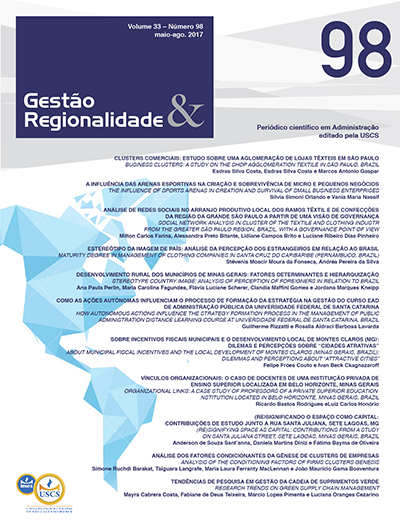(Re)signifying space as capital: contributions from a study on Santa Juliana Street, Sete Lagoas, Minas Gerais, Brazil
DOI:
https://doi.org/10.13037/gr.vol33n98.4079Abstract
Taking the approaches proposed by Bourdieu (2010) and Jacobs (2011) as a reference, this paper aims to investigate how different social agents – especially local entrepreneurs – articulate and mobilize different capitals (economic, social, cultural and symbolic) for the production of socio-spatial dynamics of diversity and vitality. A survey inspired by the Grounded Theory was then carried out and involved 41 interviews with actors inserted into the dynamics of an important street in the periphery of Sete Lagoas, MG, Brazil. As a result of empirical research, it was found that social agents mobilize the space capital as a distinction tool, extrapolating economic, social, cultural and symbolic capitals already considered in previous research (BOURDIEU, 2010). Another result gleaned from this study is the different types of personified subjects that were identified – traditional, nodern and bricoleurs – do not act within a socio-spatial vacuum, and neither are they independent from each other.
Downloads
Downloads
Published
How to Cite
Issue
Section
License
Copyright (c) 2017 Anderson De Souza Sant'Anna, Daniela Martins Diniz, FÁTIMA BAYMA DE OLIVEIRA (Autor)

This work is licensed under a Creative Commons Attribution-NonCommercial-NoDerivatives 4.0 International License.
Autores que publicam nesta revista concordam com os seguintes termos:
- Autores mantém os direitos autorais e concedem à revista o direito de primeira publicação, com o trabalho simultaneamente licenciado sob a https://creativecommons.org/
licenses/by-nc-nd/4.0/ , permitindo o compartilhamento do trabalho com reconhecimento da autoria do trabalho e publicação inicial nesta revista. - Autores têm autorização para assumir contratos adicionais separadamente, para distribuição não-exclusiva da versão do trabalho publicada nesta revista (ex.: publicar em repositório institucional ou como capítulo de livro), com reconhecimento de autoria e publicação inicial nesta revista.
- Autores têm permissão e são estimulados a publicar e distribuir seu trabalho online (ex.: em repositórios institucionais ou na sua página pessoal) a qualquer ponto antes ou durante o processo editorial, já que isso pode gerar alterações produtivas, bem como aumentar o impacto e a citação do trabalho publicado (Veja O Efeito do Acesso Livre).
























